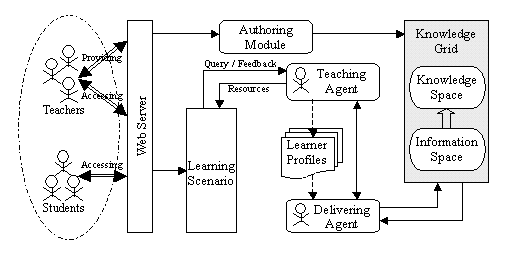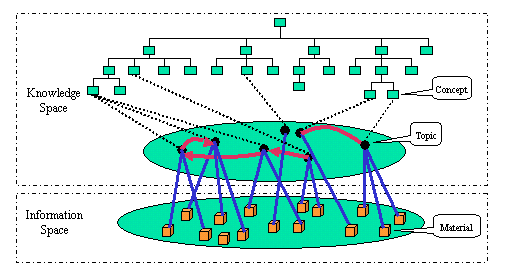
Constructivist learning is a learner-centered learning approach. Based on the Web and agent technologies, this paper proposes an open framework to effectively support constructivist learning. The framework allows the learners to freely interact with intelligent agent and other learners, enables convenient exploration of the learning resources at the learners' own paces, and provides adaptive curriculum.
Agent, Constructivist learning, Knowledge Grid, Ontology, Topic Map.
With the advancement of computer and Web technologies, e-learning is an emerging mode of education. However, most of the learning implementations concentrate on providing multitude of static web pages without considering the learner characteristics and not supporting active learning processes.
The literature in education suggests that learners who are actively engaged in the learning process will be more likely to achieve success [1]. Constructivist learning is an effective learning approach enabling a more active and explorative learning process.
The overall architecture is depicted in Figure1. Teachers and
students can communicate with the system through the Web server. Core modules are as follows:
Knowledge Grid. Knowledge Grid is an Internet-based application platform for sharing and managing the distributed heterogeneous knowledge resources in a uniform way [4].
Teaching Agent. The teaching agent serves as an
intelligent tutor by interacting with learners. It consists of three basic
components: communication component, awareness component and presentation
component. The communication component is responsible for communicating with
the delivering agent. The awareness component fulfills the task of observing
and processing the context information of the learning process. The
presentation component is in charge of presenting the resources to the
learner in the appropriate context. It also records the information gathered
through interaction with learners and accordingly updates learner profiles.
Delivering Agent. Once received a request from
the teaching agent, the delivering agent will search for corresponding
resources
in the Knowledge Grid by consulting learning profiles, and then
informs the teaching agent of the searching results. It is also responsible
for putting the collected knowledge into the Knowledge Grid.
Authoring Module. Authoring module provides friendly interface for teachers to input learning materials with semantic description information including content, context and structure annotations.
Learning scenario. It acts as a learning space that facilitates the creation, sharing and exchanging of knowledge by providing opportunity for teachers and students to work together through learning process.
Learner Profile. The learner profile is dynamically constructed according to different purposes (e.g. resources retrieval, helper location, promoting reflection, etc.), which comprises background knowledge, preferred learning style, interest, helpfulness, etc. Learners can manually edit and update profiles through the system's interface at anytime. Learnerís browsing pattern and behavior are also tracked and analyzed to obtain relevant information. Furthermore, peer evaluations can be referred to assess a learner's knowledge level and helpfulness. The underlying technology used to construct learner profile is Bayesian Network.

Figure. 1. Architecture of the constructivist learning.
The interaction functionality not only motivates the learners to learn actively, but also enables collaborative learning. Two types of interaction are supported as follows:
Interaction
between learners and teaching agent. Teaching agent should be aware of the
context of the learnerís learning process and provides relevant resources
obtained from delivering agent. On one hand, given a query proposed by a
learner, teaching agent returns appropriate learning content or recommends a
helper with the similar interest for one-to-one discussion. On the other
hand, by observing the learning process and analyzing the feedbacks from
learners, teaching agent dynamically adjusts the teaching strategy or
learning content to meet the various requirements of the learners.
Interaction among learners. Learners can exchange knowledge with flexible interaction facilities. They can synchronously discuss via chat rooms or asynchronously via e-mail or through the KCB [5]. The KCB has been implemented and is available for use online (see http://kg.ict.ac.cn), which also collects and refines the knowledge, and finally stores the knowledge in the Knowledge Grid.
An ontology is a formal, explicit specification of a shared conceptualization [2]. Topic Map is a standard used to represent and organize knowledge in a way that can be optimized for navigation [3]. Based on ontology and Topic Map, we propose a Knowledge Grid model to manage the learning resources, as shown in Figure2.

Figure2.
Knowledge Grid model for managing
learning
resources.
We design two types of ontologies: Domain Ontology and Pedagogical Ontology. The former contains a hierarchy of domain concepts, relationships between the concepts and properties of concepts. The latter contains pedagogical concepts, pedagogical structure, and pedagogical rules. Other knowledge items are organized as follows:
Topic. Knowledge elements of any granularity are represented by topics. Each topic has subsidiary attributes such as belong-to-category and master-level.
Associations.
Relationships between topics, including Generalization (is-a), Aggregation
(part-of), and Reference (peer-to-peer, e.g. prerequisite,
subsequence, remedial, analogical).
Occurrences. Each topic can be linked to one or more learning materials. A specific item is described with a 5-tuple as Oi =(URI, P1, P2, P3, P4), where URI is the physical storage location of the item Oi , Pi is the attribute value of Oi. The attributes include item-content (keywords), item-type (e.g. catalog, introduction, exercise), pedagogical-purpose (e.g. example, summary, explanation), and performance-level (e.g. remember, apply, create).
The
manually inputted learning materials are
indexed, classified and stored in the Knowledge Grid. Adaptive curriculum is
generated in terms of the semantic context, including the ontology, relationships between
topics, pedagogical
rules, and learner profile. Currently
we mainly realize the inquiry-oriented mode and in the future problem-oriented
mode should also be supported. Taken the query proposed by a learner as
the learning
goal, a curriculum is generated and delivered to guide learning towards his goal by
following a four-step process: locates the topic matching the
learning goal, performs a backward
navigation algorithm to retrieve the prerequisites to the matching topic, checks and selects the knowledge items that are not
sufficiently known by the learner, and presents a sequence of
knowledge items with flexible navigation structure in the form of
hypertext.
Additionally, three operations are provided for learners to conveniently
explore the learning resources at their own paces, including skip, horizontal-expansion and
vertical-expansion. Teaching agent will accordingly
dynamically adjust the curriculum in response to the learnersí operations. The
skip operation is to delete the specific subsection from the curriculum. The
horizontal-expansion operation is to search for more referenced materials about
the same topic, with the
purpose to present a detailed explanation or give an example, etc. In contrast
to the horizontal-expansion operation, the vertical-expansion operation is to
search for more related topics (e.g. abstract topics) to enrich learner's
knowledge. The learnerís
activities are also traced to evaluate a learnerís performance by taking into
account three factors: quiz score, review times on the same topic, and lingering
period on the topic. The learnerís performance indicates how well the topic is
learned, which is stored in the learner profile for later reference.
5.
ADAPTIVE CURRICULUM DELIVERY
6. CONCLUSION
7. ACKNOWLEDGEMENT
The research work was supported by the National Science Foundation of China
(NSFC).
8. REFERENCES